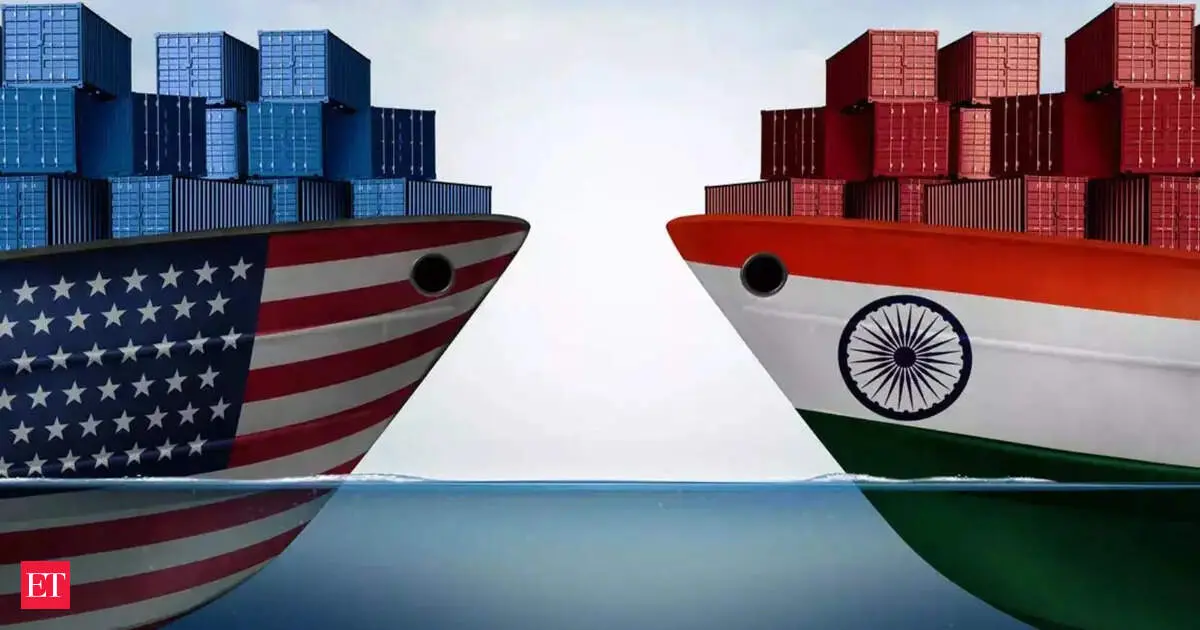New Delhi: A significant 50% tariff imposed by the US on Indian exports poses potential challenges for the Indian economy, impacting growth by approximately 0.5%. Former Commerce and Home Secretary G K Pillai highlighted that while the overall economic impact may be minimal, sectors such as textiles, gems, and seafood could face substantial challenges. With exports worth over USD 48 billion affected, industry leaders are urging the government to enhance support for exporters during this transition.
Understanding the Impact of US Tariffs on Indian Exports
Imposed recently, the hefty 50% tariff on Indian goods entering the US market has raised concerns about its long-term effects on the Indian economy. According to former Commerce and Home Secretary G K Pillai, while the immediate impact is expected to be limited to a 0.5% slowdown in growth, the repercussions may significantly affect labor-intensive sectors. Pillai pointed out that textiles, gems and jewelry, seafood exports, chemicals, and other industries could see decreased profitability in the coming months. This could lead to potential layoffs, which adds another layer of concern for workers in these industries.
For instance, a small textile factory in Tamil Nadu, which heavily relies on exports to the US, has already begun to calculate the potential fallout. Owner Ravi Kumar expressed his worries: “If we can’t find alternative markets quickly, we may have to reduce our workforce. It is a harsh reality.” Such anecdotes exemplify the human cost behind shifting trade policies and tariffs.
Labor-Intensive Sectors: The Most Vulnerable
Industries that primarily depend on labor—such as textiles and gems—are particularly vulnerable to the sudden increase in tariffs. The finance ministry has noted that while the short-term impact of such tariffs appears manageable, the secondary and tertiary effects could pose serious challenges. The textiles and clothing sector alone, expected to be one of the hardest-hit, is part of a broader ecosystem that affects millions of livelihoods across the country.
Moreover, the report from the finance ministry emphasizes the need for robust trade negotiations with the US. Ongoing discussions are critical for mitigating the adverse effects stemming from these high tariffs. In the context of a global economy that is increasingly interconnected, these negotiations will not only impact the immediate challenges but will have long-term implications for India’s trade strategy.
Government Initiatives: A Call for Support
In response to the potential fallout from these tariffs, Pillai stressed the importance of immediate action from the government. He believes that the authorities are already preparing to roll out measures aimed at supporting exporters and labor-intensive sectors. Pillai stated, “The government is in the process of working on something. These tariffs have just come into effect only yesterday. We will see in the next few weeks what measures the government takes to ensure that labor-intensive sectors are not affected.”
This sentiment echoes among various industry stakeholders who are calling for government intervention to provide the necessary tools and support for exporters. Possible measures include financial assistance and incentives for companies to explore alternative markets. As companies adapt to this rapidly changing landscape, creative business models may emerge, promoting a diversification of trade routes and potentially alleviating some of the pressures caused by the tariff.
Long-Term Strategies for Diversification
The finance ministry’s recent report underscores the importance of diversifying trade relationships. This is crucial not only for addressing the immediate shock caused by the US tariffs but also for long-term economic resilience. Initiatives such as the recently concluded Free Trade Agreement (FTA) with the UK and ongoing negotiations with the US, EU, New Zealand, Chile, and Peru are steps in the right direction. However, stakeholders are reminded that these efforts will take time to yield results.
As Ashok Mehta, an economist based in Mumbai, noted, “While we are working towards diversifying our trade, the tariffs will hit sectors suddenly. It’s imperative that exporters are given the resources and support during this transitional period.” His observations highlight the urgency with which the government should act, reinforcing the idea that responsiveness can define the future health of the Indian economy.
The Road Ahead for Indian Exporters
Overall, while the immediate impact of the US tariff on Indian exports may seem manageable, the long-term implications are profound, particularly for labor-intensive sectors. With exports worth over USD 48 billion at stake, the Indian economy’s resilience is now more essential than ever. As industries brace themselves for the repercussions, the call for government intervention and support echoes throughout the affected sectors.
In conclusion, tariffs are not just numbers on paper; they represent real challenges for millions of individuals whose livelihoods rely on these industries. The future remains uncertain, but proactive measures and strategic negotiations can pave the way for recovery and revitalization. India’s journey towards diversified trade may ultimately strengthen its economy in the face of adversity, but immediate action is critical in turning these challenges into opportunities.
Bankerpedia’s Insight💡
The recent US tariff of 50% on Indian exports could minimally impact India’s economic growth, but the effects on labour-intensive sectors like textiles and gems are concerning. This situation may lead to reduced profitability and potential job losses in the short term. For India’s banking and finance sector, the ripple effects could mean increased scrutiny over lending to affected industries. Stakeholders should remain vigilant and adaptable, exploring alternatives while the government formulates strategies to mitigate the impact. Diversification in trade is crucial for resilience in the face of such challenges.
What Does This Mean for Me?🤔
- Salaried Person → Job security could decrease due to potential layoffs.
- Business Owner → Potential profit decline and job losses in export sectors.
- Student → Reduced job opportunities in affected industries for students.
- Self-employed → Increased costs may reduce income and market opportunities.
- Homemaker → Higher prices for imported goods and potential job losses.
- Retiree / Senior Citizen → Potential job losses in export sectors may affect pensions.
- Job Seeker → Higher tariffs may limit job opportunities in affected sectors.
- Farmer / Rural Citizen → Increased costs and potential job losses in export sectors.
Research References📚
- economictimes.indiatimes.com
- RBI
- SEBI
- Ministry of Finance
- NABARD
- Department of Financial Services (DFS)
📲 Stay ahead in banking & finance!
Join the Bankerpedia WhatsApp Channel for instant updates, and
subscribe to our YouTube Channel for in-depth analysis and expert explainers.










